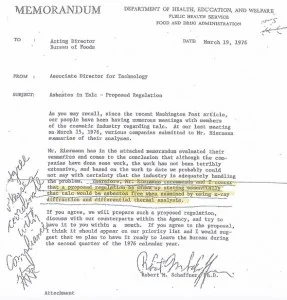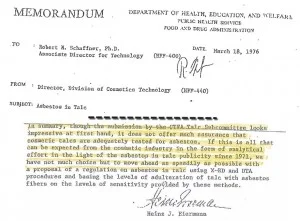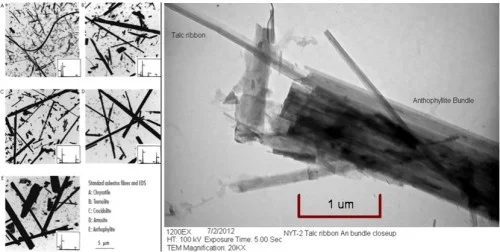Is Asbestos in Talcum Baby Powder the ‘Crime of the Century’?

Recent health and safety information has arisen with regard to asbestos contamination of common talc baby powder products, including talc products sold by Johnson Johnson, and other talcum powder products still for sale throughout the United States.
During 2016 and 2017, defective product personal injury litigation has given rise to allegations that Johnson Johnson, and other companies, have continued to sell talcum baby powder for decades adulterated by some percentage of asbestos or adulterated by what is called “asbestiform talc” (i.e. a form of talc fibers highly similar in chemical composition to asbestos fibers). Additionally, pathology studies conducted on cancerous ovary tissue, in recent ovarian cancer/talc personal injury litigation, has confirmed the presence of both talc and asbestos fibers in some tissue samples studied by specialists.
In a deposition from December 2016, one chemist described having done testing in the 1970’s of various Johnson Johnson baby powder products and having microscopically confirmed asbestos adulterating the baby powder in about 50 percent of the baby powder bottles that he tested. This was at a time that the FDA was considering regulating cosmetic talc products but J J and other consumer products companies selling cosmetic powders with talc assured the FDA that it had refined its mining methods to eliminate asbestos, and, in the end, the FDA never regulated the cosmetic talc powder products for asbestos in the United States. In other words, consumers since the 70s, buying talcum powder products, had to trust these companies not to be selling a product adulterated by asbestos. Keep in mind, asbestos was the first well known carcinogen regulated by OSHA because it is known to cause terminal mesothelioma cancers, as well as cancers to numerous tissues of the human body.
A large number of attorneys are pursuing cases around the United States alleging not only that ovarian cancers are caused by talc fibers in baby powder products, but new suits are being filed alleging that many talcum powder products are still contaminated with asbestos. Some lawsuits have also been filed alleging that pleural mesothelioma, peritoneal mesotheliomas, and several other cancers are not only tied to talc baby powder products but may have been caused by adulterating asbestos or asbestiform talc fibers contained in these common consumer baby powder products.
Johnson and Johnson, the leading retailer of talc baby powder, has steadfastly refused to put any warning on their talc baby powder products, whether the warnings advise of higher rates of cancer in general, of potential adulteration with asbestos, or even that talc has been associated with higher rates of ovarian cancers. After hearing the evidence in a number of court cases, juries have sided with the women suffering ovarian cancers in the majority of the trials over the last year. Juror interviews during 2017 indicated that many were appalled that J J resisted placing any warnings on the talc baby powder products, based on the totality of the evidence.
Let’s Go Back to the 1970s
The government was seriously considering regulating talc in cosmetic powders since there was solid evidence asbestos was in these products. The industry needed to tamp down the call for regulations and had to convince regulators that they would remove all the adulteration with asbestos. But how? The talc industry decided to provide the regulators with testing that they conducted (without direct government oversight) to show virtually no asbestos was in their current baby powder talc products. Just how serious were the regulators in the 70s? Read the two memos below, shown in pertinent excerpts:


Caption: FDA 1976 memos.
Yes, the FDA was ready to regulate but then the talc industry, including J J, Colgate, Chesebrough-Ponds, and others, provided various tests by private consultants, to show that the asbestos adulteration was virtually nil or zero.
Then a Whistleblower Came Forward
Why do whistleblowers step forward? What motivates them? Is it simply the desire to reveal the truth? What if there is no compensation? A whistleblower came forward n December 2016 in one of the pending J J ovarian cancer baby powder cases pending in St. Louis, Missouri. He was working on his Ph.D. under a then-noted chemist who was hired by the talc industry to test their products in the 1970s. This young chemist, Aviam Elkies planned to study under the New York chemist, Dr. Lewin, and his role was to test the J J baby powder products for the presence of asbestos fibers.
Elkies never finished his Ph.D. under Dr. Lewin when the study funding was cancelled by J J. He later moved to Israel where he taught chemistry for many years, but he never forgot what happened when he worked on this aborted project. When he heard about allegations of asbestos in J J talcum baby powder in the international press, he contacted one of the plaintiff’s lawyers mentioned in the news article.
Surrounded by plaintiff product liability attorneys and talc mine and baby powder retailer attorneys, he gave the sworn testimony excerpted below on December 15, 2016.
There are hundreds of pages of additional testimony where the talc industry attorneys sought to discredit this brave whistleblower. But the point was irrefutable: the industry deep sixed the studies that showed asbestos adulteration in baby powder with talc.
Attorneys for women who suffer from, or died due to ovarian cancer are studying whether the fine talc fibers alone cause the higher rates of ovarian cancers, or whether the combination of talc and asbestos fibers both cause the higher rates of cancers.
Talc Mineral Structure Is Similar to Asbestos Structure
Because talc and asbestos are both silicates formed by similar geological conditions, they often form in similar geographical locations in the Earth. In the proper geological conditions, talc can (over millions of years) change into asbestos, and asbestos can change into talc. Viewed under a microscope, there are fibers also known as asbestiform talc, which chemists distinguish only by the microscopic width and length of the fibers. In the Earth, talc and asbestos are often mined near to each other, as they form in similar mine veins. Geologists and mineralogists have studied and known about the similarity in talc and asbestos for over a century. The microscopic structure of asbestos and talc is shown below.

Caption: On left, various forms of asbestos fibers, at right a talc ribbon next to an asbestos bundle.
In a study reported during 2015, scientists confirmed that dozens and dozens of Cashmere Bouquet talcum powder containers were adulterated with asbestos. The product had been sold for decades but Colgate sold off the brand in 1995. Why? Perhaps it was not a successful product, perhaps Colgate was concerned about asbestos adulteration liability. Colgate can still be held liable for an adulterated talc powder which was laced with asbestos when it sold the product, and indeed Colgate lost a mesothelioma suit in 2016 by a long term talcum powder user (this terminal cancer has a latency period of 10 to 50 years).
Crime of the Century or Fraud of the Century?
Imagine a Hollywood suspense movie where the villain has knowingly adulterated a very common consumer product with poison carcinogens known to cause myriad cancers, and that these horrible cancers can arise years or decades later, causing tens of thousands of deaths.
Imagine that the villain adulterates what is considered one of the safest consumer products imaginable, that has been sold without warnings in the United States for well over 100 years, that product being baby powder.
Then imagine that in the last act of the movie the villain is unmasked, and the public demands swift and commensurate punishment of the villain.
Now imagine that the villain turns out to be one of the most trusted consumer product companies.
Would keeping this secret from the public and from government regulators be considered the crime of the century? Perhaps not, because it may or may not be a criminal act, but it could be a significant fraudulent act, a material concealment, a massive civil wrong tied to countless thousands of cancers and deaths stretching over decades.
Whether this alleged concealment by the talc industry is the fraud of the century will continue playing out in the state and federal civil courtrooms of the United States over months and years. Who knew what and when? Have thousands of women died for decades from (supposedly safe) talc baby powder? Stay tuned.






